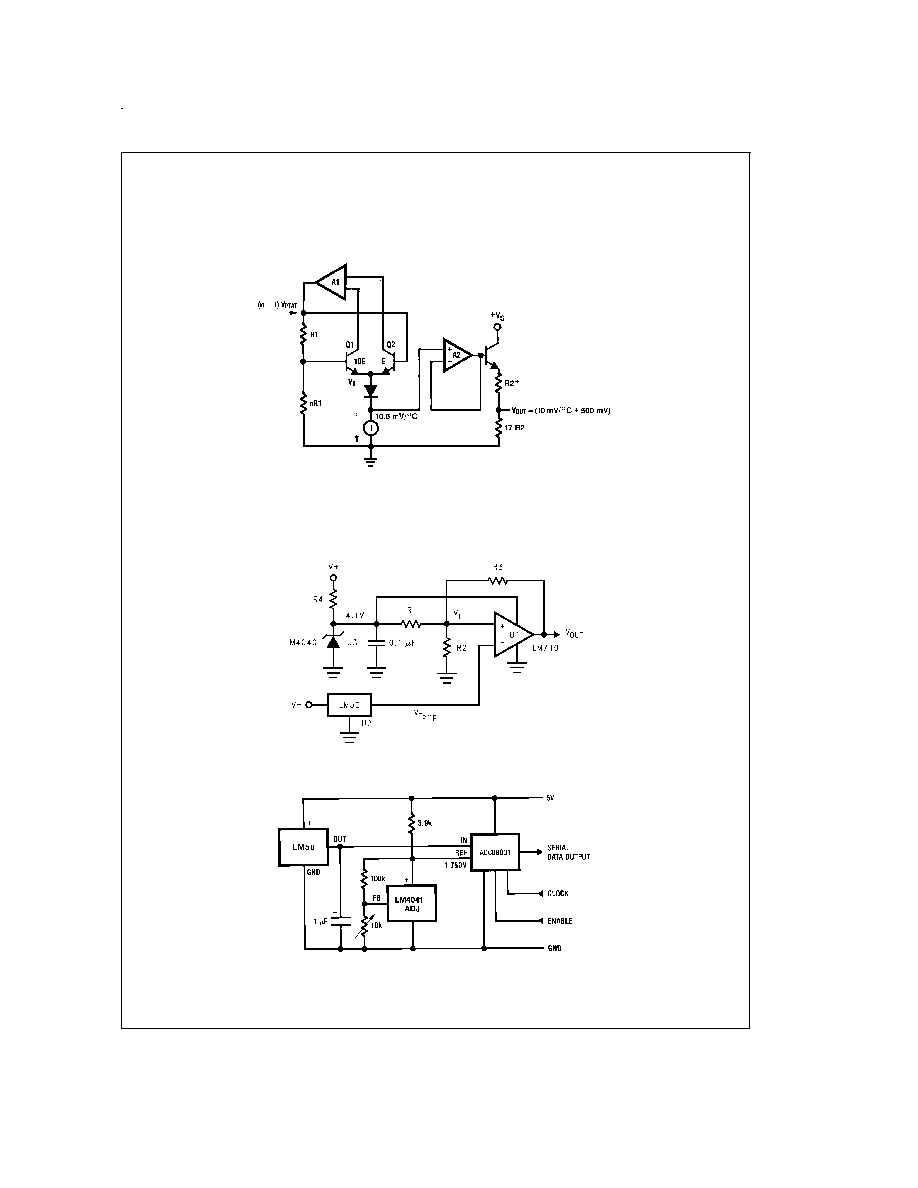Äîêóìåíòàöèÿ è îïèñàíèÿ www.docs.chipfind.ru

LM50
SOT-23 Single-Supply Centigrade Temperature Sensor
General Description
The LM50 is a precision integrated-circuit temperature sen-
sor that can sense a -40°C to +125°C temperature range us-
ing a single positive supply. The LM50's output voltage is lin-
early proportional to Celsius (Centigrade) temperature
(+10 mV/°C) and has a DC offset of +500 mV. The offset al-
lows reading negative temperatures without the need for a
negative supply. The ideal output voltage of the LM50 ranges
from +100 mV to +1.75V for a -40°C to +125°C temperature
range. The LM50 does not require any external calibration or
trimming to provide accuracies of
±
3°C at room temperature
and
±
4°C over the full -40°C to +125°C temperature range.
Trimming and calibration of the LM50 at the wafer level as-
sure low cost and high accuracy. The LM50's linear output,
+500 mV offset, and factory calibration simplify circuitry re-
quired in a single supply environment where reading nega-
tive temperatures is required. Because the LM50's quiescent
current is less than 130 µA, self-heating is limited to a very
low 0.2°C in still air.
Applications
n
Computers
n
Disk Drives
n
Battery Management
n
Automotive
n
FAX Machines
n
Printers
n
Portable Medical Instruments
n
HVAC
n
Power Supply Modules
Features
n
Calibrated directly in degree Celsius (Centigrade)
n
Linear + 10.0 mV/°C scale factor
n
±
2°C accuracy guaranteed at +25°C
n
Specified for full -40° to +125°C range
n
Suitable for remote applications
n
Low cost due to wafer-level trimming
n
Operates from 4.5V to 10V
n
Less than 130 µA current drain
n
Low self-heating, less than 0.2°C in still air
n
Nonlinearity less than 0.8°C over temp
Connection Diagram
Order
SOT-23
Supplied As
Number
Device Marking
LM50BIM3
T5B
1000 Units on Tape
and Reel
LM50CIM3
T5C
1000 Units on Tape
and Reel
LM50BIM3X
T5B
3000 Units on Tape
and Reel
LM50CIM3X
T5C
3000 Units on Tape
and Reel
Typical Application
SOT-23
DS012030-1
Top View
See NS Package Number MA03B
DS012030-3
FIGURE 1. Full-Range Centigrade Temperature Sensor (-40°C to +125°C)
July 1999
LM50
SOT-23
Single-Supply
Centigrade
T
emperature
Sensor
© 1999 National Semiconductor Corporation
DS012030
www.national.com

Absolute Maximum Ratings
(Note 1)
Supply Voltage
+12V to -0.2V
Output Voltage
(+V
S
+ 0.6V) to -1.0V
Output Current
10 mA
Storage Temperature
-65°C to +150°C
Lead Temperature:
SOT Package (Note 2):
Vapor Phase (60 seconds)
215°C
Infrared (15 seconds)
220°C
T
JMAX
, Maximum
Junction Temperature
150°C
ESD Susceptibility (Note 3):
Human Body Model
Machine Model
2000V
250V
Operating Ratings
(Note 1)
Specified Temperature Range:
T
MIN
to T
MAX
LM50C
-40°C to +125°C
LM50B
-25°C to +100°C
Operating Temperature Range
-40°C to +150°C
JA
(Note 4)
450°C/W
Supply Voltage Range (+V
S
)
+4.5V to +10V
Electrical Characteristics
Unless otherwise noted, these specifications apply for V
S
= +5 V
DC
and I
LOAD
= +0.5 µA, in the circuit of Figure 1. Boldface
limits apply for the specified T
A
= T
J
= T
MIN
to T
MAX
; all other limits T
A
= T
J
= +25°C, unless otherwise noted.
Parameter
Conditions
LM50B
LM50C
Units
(Limit)
Typical
Limit
Typical
Limit
(Note 5)
(Note 5)
Accuracy
T
A
= +25°C
±
2.0
±
3.0
°C (max)
(Note 6)
T
A
= T
MAX
±
3.0
±
4.0
°C (max)
T
A
= T
MIN
+3.0, -3.5
±
4.0
°C (max)
Nonlinearity (Note 7)
±
0.8
±
0.8
°C (max)
Sensor Gain
+9.7
+9.7
mV/°C (min)
(Average Slope)
+10.3
+10.3
mV/°C (max)
Output Resistance
2000
4000
2000
4000
(max)
Line Regulation
+4.5V
V
S
+10V
±
0.8
±
0.8
mV/V (max)
(Note 8)
±
1.2
±
1.2
mV/V (max)
Quiescent Current
+4.5V
V
S
+10V
130
130
µA (max)
(Note 9)
180
180
µA (max)
Change of Quiescent
+4.5V
V
S
+10V
2.0
2.0
µA (max)
Current (Note 9)
Temperature Coefficient of
+1.0
+2.0
µA/°C
Quiescent Current
Long Term Stability (Note 10)
T
J
= 125°C, for
±
0.08
±
0.08
°C
1000 hours
Note 1: Absolute Maximum Ratings indicate limits beyond which damage to the device may occur. DC and AC electrical specifications do not apply when operating
the device beyond its rated operating conditions.
Note 2: See AN-450 "Surface Mounting Methods and Their Effect on Product Reliability" or the section titled "Surface Mount" found in a current National Semicon-
ductor Linear Data Book for other methods of soldering surface mount devices.
Note 3: Human body model, 100 pF discharged through a 1.5 k
resistor. Machine model, 200 pF discharged directly into each pin.
Note 4: Thermal resistance of the SOT-23 package is specified without a heat sink, junction to ambient.
Note 5: Limits are guaranteed to National's AOQL (Average Outgoing Quality Level).
Note 6: Accuracy is defined as the error between the output voltage and 10mv/°C times the device's case temperature plus 500 mV, at specified conditions of volt-
age, current, and temperature (expressed in °C).
Note 7: Nonlinearity is defined as the deviation of the output-voltage-versus-temperature curve from the best-fit straight line, over the device's rated temperature
range.
Note 8: Regulation is measured at constant junction temperature, using pulse testing with a low duty cycle. Changes in output due to heating effects can be com-
puted by multiplying the internal dissipation by the thermal resistance.
Note 9: Quiescent current is defined in the circuit of
Figure 1 .
Note 10: For best long-term stability, any precision circuit will give best results if the unit is aged at a warm temperature, and/or temperature cycled for at least 46
hours before long-term life test begins. This is especially true when a small (Surface-Mount) part is wave-soldered; allow time for stress relaxation to occur. The ma-
jority of the drift will occur in the first 1000 hours at elevated temperatures. The drift after 1000 hours will not continue at the first 1000 hour rate.
www.national.com
2

Typical Performance Characteristics
To generate these curves the LM50 was mounted to a printed
circuit board as shown in
Figure 2.
Thermal Resistance
Junction to Air
DS012030-21
Thermal Time Constant
DS012030-22
Thermal Response in Still Air
with Heat Sink (
Figure 2)
DS012030-23
Thermal Response
in Stirred Oil Bath
with Heat Sink
DS012030-24
Start-Up Voltage
vs Temperature
DS012030-25
Thermal Response in Still
Air without a Heat Sink
DS012030-26
Quiescent Current vs
Temperature (
Figure 1)
DS012030-27
Accuracy vs Temperature
DS012030-28
Noise Voltage
DS012030-29
www.national.com
3

Typical Performance Characteristics
To generate these curves the LM50 was mounted to a printed
circuit board as shown in
Figure 2. (Continued)
1.0 Mounting
The LM50 can be applied easily in the same way as other
integrated-circuit temperature sensors. It can be glued or ce-
mented to a surface and its temperature will be within about
0.2°C of the surface temperature.
This presumes that the ambient air temperature is almost the
same as the surface temperature; if the air temperature were
much higher or lower than the surface temperature, the ac-
tual temperature of the LM50 die would be at an intermediate
temperature between the surface temperature and the air
temperature.
To ensure good thermal conductivity the backside of the
LM50 die is directly attached to the GND pin. The lands and
traces to the LM50 will, of course, be part of the printed cir-
cuit board, which is the object whose temperature is being
measured. These printed circuit board lands and traces will
not cause the LM50s temperature to deviate from the de-
sired temperature.
Alternatively, the LM50 can be mounted inside a sealed-end
metal tube, and can then be dipped into a bath or screwed
into a threaded hole in a tank. As with any IC, the LM50 and
accompanying wiring and circuits must be kept insulated and
dry, to avoid leakage and corrosion. This is especially true if
the circuit may operate at cold temperatures where conden-
sation can occur. Printed-circuit coatings and varnishes such
as Humiseal and epoxy paints or dips are often used to en-
sure that moisture cannot corrode the LM50 or its connec-
tions.
Temperature Rise of LM50 Due to Self-Heating
(Thermal Resistance,
JA
)
SOT-23
SOT-23
no heat sink
*
small heat fin
**
Still air
450°C/W
260°C/W
Moving air
180°C/W
*
Part soldered to 30 gauge wire.
**
Heat sink used is
1
/
2
" square printed circuit board with 2 oz. foil with part at-
tached as shown in
Figure 2.
2.0 Capacitive Loads
The LM50 handles capacitive loading very well. Without any
special precautions, the LM50 can drive any capacitive load.
The LM50 has a nominal 2 k
output impedance (as can be
seen in the block diagram). The temperature coefficient of
the output resistors is around 1300 ppm/°C. Taking into ac-
count this temperature coefficient and the initial tolerance of
the resistors the output impedance of the LM50 will not ex-
ceed 4 k
. In an extremely noisy environment it may be nec-
essary to add some filtering to minimize noise pickup. It is
recommended that 0.1 µF be added from V
IN
to GND to by-
Supply Voltage
vs Supply Current
DS012030-30
Start-Up Response
DS012030-31
DS012030-19
FIGURE 2. Printed Circuit Board Used
for Heat Sink to Generate All Curves.
1
/
2
" Square Printed Circuit Board
with 2 oz. Foil or Similar
DS012030-7
FIGURE 3. LM50 No Decoupling Required
for Capacitive Load
DS012030-8
FIGURE 4. LM50C with Filter for Noisy Environment
www.national.com
4

2.0 Capacitive Loads
(Continued)
pass the power supply voltage, as shown in
Figure 4. In a
noisy environment it may be necessary to add a capacitor
from the output to ground. A 1 µF output capacitor with the
4 k
output impedance will form a 40 Hz lowpass filter. Since
the thermal time constant of the LM50 is much slower than
the 25 ms time constant formed by the RC, the overall re-
sponse time of the LM50 will not be significantly affected. For
much larger capacitors this additional time lag will increase
the overall response time of the LM50.
3.0 Typical Applications
DS012030-17
*R2
2k with a typical 1300 ppm/°C drift.
FIGURE 5. Block Diagram
DS012030-11
FIGURE 6. Centigrade Thermostat/Fan Controller
DS012030-13
FIGURE 7. Temperature To Digital Converter (Serial Output) (+125°C Full Scale)
www.national.com
5




